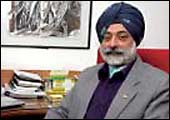 |
A "growth
process that is much more inclusive," is what the Prime Minister
wanted. And P. Chidambaram obliged. And how! A little more than
half of his 103-minute Budget 2007-08 speech was devoted to essential
services that urban city slickers wouldn't ponder over for too
long: Drinking water and sanitation, rural roads and houses, health
and family welfare, polio eradication...and of course the big
A, agriculture. "One of the major positive features of the
Budget has been its prime focus on education and healthcare. The
Budget aims at improving access to social services and provides
a social safety net," says Dr Siddhartha Roy, Economic Advisor,
Tata Group. The step-up in outlays for these sectors are significant,
though not eye-popping. Bharat Nirman, a four-year programme for
building rural infrastructure, for instance, will now witness
a 31.6 per cent increase in budgetary allocation, up to Rs 24,603
crore. The provision for education is up 34.2 per cent to Rs 32,352
crore, and for health and family welfare it's almost 22 per cent
higher, at Rs 15,291 crore. The stated objectives of these increases
are higher growth in the agricultural sector, faster employment
creation, and access to basic physical infrastructure, health
and education for all. The final milestone: A growth rate of 10
per cent by 2011, which is when the 11th five-year Plan period
ends. Here's how Chidambaram hopes to get there:
Agriculture's New Lifeline
The agriculture sector, much neglected in
the past, received a shot in the arm in the 2007-08 Budget. The
aim: To nudge the growth rate to an average of 4 per cent during
the 11th Plan period (2007-2011), as against the dismal 2.3 per
cent recorded during the 10th Plan period (2002-07). The prescription:
More farm credit to boost investments; strengthening state-owned
institutions in the sector; higher investments in irrigation projects;
measures to improve efficiency in the farm sector; and additional
help for distressed districts by way of low-cost loans.
| FOCUS ON THE FARM |
»
Farm credit target for 2007-08 fixed at Rs 225,000
crore as against the previous year's Rs 175,000 crore (which
has been exceeded). 50 lakh new farmers expected to enter
the banking system
» Budget
for fertiliser subsidies increased from Rs 17,253 crore
in 2006-07 to Rs 22,452 crore
» To
improve the quality and increase the quantity of certified
seeds, the Integrated Oilseeds, Oil Palm, Pulses and Maize
Development Programme will be expanded. The government will
offer a capital grant or concessional financing to producers
in a bid to double production of certified seeds within three
years
» Special
plan-which includes water-related schemes and schemes
for inducting high-yielding milch animals and related activities-being
implemented over three years in 31 "especially distressed"
districts in four states, involving Rs 16,979 crore
» A
special-purpose tea fund has been launched; similar mechanisms
to rejuvenate the coffee, rubber, spices, cashew and coconut
sectors to be flagged off
» Outlay
for the Accelerated Irrigation Benefit Programme (AIBP)
to be increased from Rs 7,121 crore in 2006-07 to Rs 11,000
crore. Grant component to state governments will increase
to Rs 3,580 crore
» World
Bank has signed a Rs 2,182 crore loan agreement with Tamil
Nadu to restore 5,763 water bodies. A similar agreement is
expected to be concluded for Andhra Pradesh, Karnataka and
Orissa soon
» Government
to transfer Rs 1,800 crore to NABARD to enable 100 per
cent subsidies to small and marginal farmers, and 50 per cent
subsidy to other farmers, to create millions of "dug
wells" (into which rain water is diverted)
» Rs
100 crore for a training programme to train farmers in
water harvesting
» Provision
for the Agriculture Technology Management Agency increased
from Rs 50 crore to Rs 230 crore
» Provision
of Rs 500 crore for the National Agricultural Insurance
Scheme, and Rs 100 crore allocated for a weather-based crop
insurance pilot scheme, to be started by the Agricultural
Insurance Corp.
» Nabard
to issue rural bonds worth Rs 5,000 crore, which will
be guaranteed by the government, and be eligible for tax exemptions
|
It's doubtless a sound prescription, but
that on its own may not be enough to fix the sector's woes, many
of which have turned chronic. These include the lack of investments,
poor irrigation systems, overdependence on monsoons, low quality
seeds and numerous intermediaries that cut into farmer's income.
The question, though, is: Are the fm's revenue-expending initiatives
adequate to hit the targeted growth of 4 per cent in the years
ahead? Maybe not, feels Roy of the Tata Group. "In the absence
of any fresh capital schemes, which could kick-start long-term
growth in this sector, it is difficult to envisage a 4 per cent
growth rate in agriculture in 2007-08, leave alone averaging a
4 per cent growth during the 11th plan," he shrugs. The government's
think-thank would beg to differ. Says Saumitra Chaudhuri, Member,
Prime Minister's Economic Advisory Council: "The ingredients
for a success story are there in the Budget. The task ahead is
that of delivering results. Yes, if the measures are delivered
with reasonable efficiency, a 4 per cent growth rate (in agriculture)
during the 11th Plan period is achievable."
 |
"The ingredients
for a success story are there. If the measures are delivered
with reasonable efficiency, a 4 per cent growth rate (in agriculture)
is achievable"
SOUMITRA CHAUDHURI
Member, PM's Economic Advisory Council |
While farm credit has doubled in the last
two years, the Finance Minister hopes to do better in the following
year. He expects it to rise to Rs 2,25,000 crore this year and
in the process add another 50 lakh farmers to the banking system.
To catalyse this development, banking norms with regard to bad
and doubtful debts will be eased. To ensure that the economics
of the business do not convert the lending business into a losing
proposition, Chidambaram has raised the government funding for
irrigation by around Rs 5,000 crore to Rs 11,000 crore and increased
the grant component to states by as much as Rs 1,000 crore to
Rs 2,350 crore.
Taking a leaf from the Green Revolution in
the 1960s that brought about self-sufficiency in key farm products,
Chidambaram has mooted strengthening the state-owned institutions
like the Indian Council of Agricultural Research and the state
agricultural universities. The objective is to provide 100 trainers,
and train 1,000 farmers every year in various farming practices,
including water harvesting. To enable this, the government will
provide an interest-free loan of Rs 3 crore per institution as
corpus. Complementing this exercise will be a revamp of the prevailing
Training and Visit (T&V) programme, where experts from agriculture
institutes visit the farm and impart new techniques. The Agriculture
Technology Management Agency, which is present in 262 districts,
will now expand its operations to 300 districts. Additional funding
to the tune of Rs 180 crore will be provided for this purpose.
Besides a strong dose of funding, the farm
sector is in dire need of good seeds; the private sector, so far,
has not found it viable to develop non-hybrid variety seeds. Realising
this inadequacy, which can be filled for the moment only by the
state, the Finance Minister has decided to strengthen the Indian
Institute of Pulses. The investments are aimed at doubling the
production of certified seeds in three years. This will improve
crop production, especially, in the case of oilseeds, pulses,
oil palm and maize.
 |
"It's heartening that
the Finance Minister has taken a number of steps to improve
public health. They are all welcome steps"
DALJIT SINGH
President/ Fortis Healthcare |
While the Finance Minister has outlined the
proposals in his Budget, the Agriculture Ministry will prepare
the implementation programme for the various proposals. And, therein
lies the rub, argue experts. Given the government's inefficient
delivery mechanism, it will be a tall order task to ensure that
benefits accrue to the targeted lot. Agrees the Finance Minister:
"Implementation is a very important aspect of the programme."
With 60 per cent of the country's population depending on agriculture
for their bread and butter, finding the right fix for the agri-sector
is critical.
Healthcare in the Hinterland
If agriculture got its due in the fm's budget
speech, health and family welfare wasn't far behind, what with
Chidambaram proposing to increase the allocation on this front
by 21.9 per cent, to Rs 15,291 crore. While the much-awaited National
Urban Health Mission as well as the National Pharmaceutical Policy
are yet to be announced, the institutional integration of all
the health schemes at the district and lower levels have been
achieved under the National Rural Health Mission (NRHM). All districts
in the country will complete preparation of District Health Action
Plans by March 2007 and the allocation for the NRHM has been increased
from Rs 8,207 crore in 2006-07 to Rs 9,947 crore in 2007-08. Through
Monthly Health Days (MHD) organised at Anganwadi centres, the
government plans to bring together various programmes such as
immunisation, antenatal care as well as nutrition and sanitation.
While 320,000 Associated Social Health Activists (ASHAs) have
been recruited and over 200,000 have received orientation training,
another 90,000 link workers have been selected by the states.
Ayurveda, Yoga & Naturopathy, Unani, Sidha and Homeopathy
systems are also being mainstreamed into the health delivery system
at all levels. Says Naresh Trehan, Executive Director, Escorts
Heart Institute and Research Centre: "The direction of the
Budget is laudable. Finally, the rural sector, (education) and
healthcare are getting attention."
 |
"Increased allocations
for safe drinking water and sanitation are welcome, but at
best they sustain initiatives of the past"
SATISH REDDY
MD/ Dr Reddy's Laboratories |
Consider, for instance the polio eradication
programme, which has now been integrated into the NRHM. The ASHAs
and the Anganwadi workers will visit every household and track
every child for the immunisation programme. The number of polio
rounds will be increased, monovalent vaccine will be introduced,
and there will be intensive coverage in the 20 high-risk districts
of Uttar Pradesh and 10 districts of Bihar. To achieve the goal
of eliminating polio, Rs 1,290 crore has been provided for 2007-08.
The National aids Control Programme (NACP)-III,
which will start in 2007-08 by building on NACP-I and NACP-II,
will target high-risk groups in all states. More hospitals will
provide treatment to prevent transmission of HIV/AIDS from mother
to child. Support will be given to the protocol on paediatric
dosage developed by Indian doctors and launched in November 2006.
For 2007-08, the provision for aids control has been raised to
Rs 969 crore. Daljit Singh, President (Strategy and Organisational
Development), Fortis Healthcare, says: "It's heartening that
the Finance Minister has taken a number of steps in improving
public health. So, increased allocation for the NRHM, Rs 969 crore
for aids control, provision for polio eradication and increased
allocation for Integrated Child Development Services are all welcome
steps."
But there's still a lot more hard work left
to be done. "There is no direction on implementation or what
models will be used," he adds. And there are those who don't
see any radical, or even fresh, initiatives in the fm's budgetary
proposals. Says Satish Reddy, Managing Director & coo, Dr
Reddy's Laboratories: "Increased allocations to the National
Rural Health Mission and for safe drinking water and sanitation
are welcome, but at best they sustain initiatives of the past."
Reddy adds that health being a state subject brings along its
own set of problems. "It is clear that few states have the
money to make a difference and the Finance Minister has chosen
not to make an effort to alter the status quo."
Education: Building a Knowledge Economy
India's schools mirror its painful struggle
to transform an unequal and ignorant society into an equal and
enlightened one. Look into this mirror and you see images that
inspire as much hope as despair. Hope because India's recent economic
success rests on its enlightened workforce (think IT, pharma and
biotech) and despair because knowledge hasn't filtered into a
greater part of the Indian population. Now, with Chidambaram kick-starting
outlays in education (see Education Gets a Leg-up), it's the hope
that's in the limelight.
 |
"Building a regular
cadre of teachers is a must but it should go hand in hand
with more accountability for teachers"
GAUTAM PURI
Managing Director/ Career Launcher |
"Until the early 1990s, the government
still believed that there is no demand for education among a number
of backward communities. The recognition for huge demand for education
only met with reduced spend on education and other social sectors
in the early 1990s when reforms were kick-started. I am inclined
to believe that things are changing though we still are grappling
with the issues of poor access, quality and equity," says
Sukanya Bose, a Delhi-based economist who has worked with Economic
Research Foundation, a non-profit research outfit, on expanding
educational opportunities. O.N. Singh, Commissioner, Navodaya
Vidyalaya Samity, which runs residential schools for talented
but underprivileged children in rural areas, says Chidambaram
has nudged India nearer to the league of developed nations that
spend huge amounts on education. "A 35 per cent increase
in school education is a great leap forward in expanding access,"
he says.
But that may not be good enough. Arvind Sardana,
an educationist at Eklavya, an NGO that has helped over 500 government
schools in improving the quality of education, says enhanced allocations
for education mean little unless the fundamental issue of quality
of education is addressed. "A high drop-out rate is a direct
result of the poor quality of education. What's disturbing is
that instead of building a regular cadre of teachers, states have
been hiring para teachers (on short-term contracts) who get one
third of the salary received by regular teachers," points
out Sardana. Gautam Puri, MD, Career Launcher, says building a
regular cadre of teachers is a must but it should go hand in hand
with more accountability for teachers.
 |
| The medium is the message: The allocation
for AIDS control has been increased to Rs 969 crore |
Bose says motivated and engaged teachers represent
just one of the desiderata. "In rural areas, most of the
pupils are first generation learners, whose parents have never
had any education. Many of them also belong to the downtrodden
communities. These pupils have special needs that can only be
addressed by motivated, sensitive and engaged teachers,"
she says. Yet Bose is heartened by the proposal to turn 1,396
Industrial Training Institutes (ITIs) into centres of excellence
through public-private partnership because vocational education
must build stronger linkages with industry. She also welcomes
the additional 1 per cent cess for secondary and higher education
as the growing number of primary school graduates needs more secondary
school infrastructure. "Doubling the allocation for secondary
education, 1 lakh scholarships for 8th standard pass under the
National Means-cum-Merit Scholarship Scheme and a 1 per cent additional
cess for secondary education mean that India is serious about
education. They are all welcome steps," Puri adds.
|



